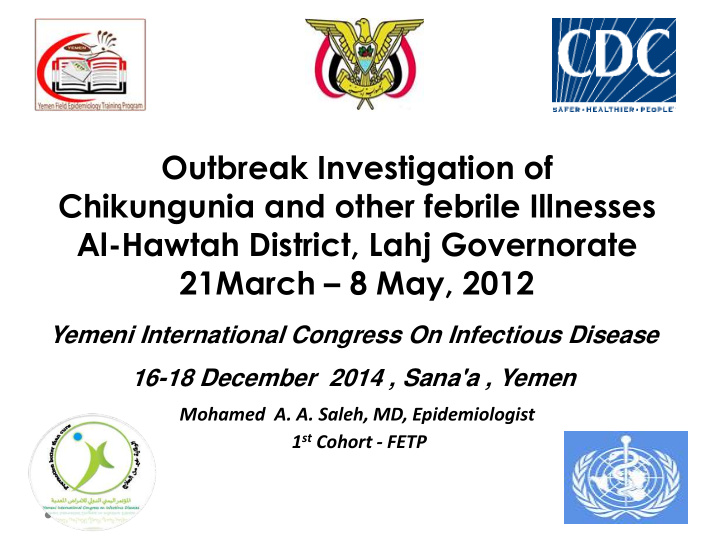



Outbreak Investigation of Chikungunia and other febrile Illnesses Al-Hawtah District, Lahj Governorate 21March – 8 May, 2012 Yemeni International Congress On Infectious Disease 16-18 December 2014 , Sana'a , Yemen Mohamed A. A. Saleh, MD, Epidemiologist 1 st Cohort - FETP
Background • Chikungunya virus(CHIKV)is an acute viral infection • Transmitted to humans through bite of an infected adult female Aedes mosquito • It is one of the epidemic vector-borne diseases, recently re-emerged in Asian and African • First reported case in humans was in Tanzania in 1952
Background • In Yemen , the CHIKV was first confirmed in Al- Hodeida governorate in late 2010 • Dengue fever which has a clinical manifestation similar to CHIKV is also reported from Yemen • The disease in Yemen occurs yearly in the period between October to April
Background • Lahj governorate experienced a major dengue fever outbreak, notably March and May 2010 • In 18 April 2012, first three cases of CHIKV reported from Al-Hawtah district, Lahj governorate • In 21 April 2012 another 20 cases were reported • FETP residents asked to investigate the outbreak
Objectives • Confirm diagnosis of outbreaks • Describe characteristic of cases • Recommend control and prevention measures to local health authorities and help implementation
Methods • The investigation took place in Al-Hawtah district between 21 April – 8 May,2012 • Active house to house search • Investigation form used to collect demographic and clinical data of cases • Line listing was developed • 10 blood samples collected and sent to central
Methods (cont.) Case Definition • Suspected CHIKV Case – Acute Febrile Illness and severe joint pain/joint swelling/joint stiffness/arthritis with one of the following sign/symptoms: • Severe headache • Retro-orbital pain, Muscle pain, Bone pain • Rash AND – No evidence of haemorrhagic manifestation – Normal PLT count ( > 100,000 cell/mL) – Malaria was negative
Methods (cont.) Case Definition • Probable CHIKV Case – Met suspected case Chikungunya fever criteria AND one of the following • epidemiological linkage with confirmed case • Single positive CHIKV IgM • Confirmed CHIKV Case – Met suspected case Chikungunya fever criteria AND one of the following • Identify CHIK virus by PCR and/or Viral isolation • Two fold rising of CHIKV IgM from pair serum
Methods (cont.) • Environmental Survey to look for breeding sites • Entomological survey to identify the mosquito and larvae • Data collected was entered and analyzed using Epi Info and excel
Results • A total of 234 CHIK cases met the case definition • The index case is a child of 14 year age with date of onset 21 March, 2012 • The attack rate was 7.5 per1000 population • No deaths occurred among the suspected cases
No. of cases 10 15 20 25 Fig 1. Distribution of the cases by date of onset, 0 5 19-Mar Index case 21-Mar 23-Mar 25-Mar 27-Mar 29-Mar 31-Mar confirmed suspect 02-Apr Lahj, Yemen 2012 04-Apr 06-Apr 08-Apr 10-Apr days 1st report 12-Apr 14-Apr 16-Apr 18-Apr school health education house to house and 20-Apr 22-Apr indoor fogging 24-Apr 26-Apr 28-Apr 30-Apr 02-May 04-May 06-May 08-May 10-May 12-May
Fig 2. Clinical Manifestation of Chikungunya fever cases fever 100 headache 100 arthralgia 95 joints swelling 64 rash 56 bleeding 0.4 0 20 40 60 80 100 %
Table 1: Incidence rate of cases by gender and age group No. Incidence Population cases per 1000 Gender 15876 122 8 M 15253 112 7 F Age group 7657 45 6 <10 6947 44 6 10-19 6762 57 8 20-29 4235 32 8 30-39 5528 56 10 40+ 31129 234 8 Total
Fig 3: Location of Chikungunya outbreak in Lahj Governorate
Fig 4: Distribution of the cases by district 250 209 Al-Hawtah sub district 200 OTHER ARIA 48% 150 No Cases FISH MARKET 52% 100 46% 48% 50% 52% 50 23 1 0 Al-Hawtah Tuban Almusamir District
Laboratory Results • Three cases were CHIKV IgM positive (ELISA) • One case was dengue IgM positive
Environmental Survey Main container type water reservoir in the household
Entomological Survey • In 9 sites in Al Hawtah district major containers examined for mosquito breeding site • In all sites adult Aedes spp mosquito and mosquito larva isolated
Entomological Results Al-hawtah Fish District market 121 No. House Exam. 332 60 House Positive 132 50% House Index (%) 40% 245 Container Exam 1699 68 Container Positive 217 28% Container Index (%) 13% 50% Breteau Index (%) 0.20
Actions taken • Integrated meeting with malaria, surveillance, and education programs • Met medical and paramedical staff (midwives) in MCHC and Ibn Khaldon hospital • Met district health office and education directors in Al-Hawtah and Tuban districts • Met the coordinators of the school health program for health education of students • In door fogy spray for an entire Al-Hawtah District started
Meeting activities
Training Activities
Indoor fogy spray Activities
Conclusion • Lahj outbreak is most probably due to CHIKV • Importation of the CHIKV from another governorate is likely e.g. fishermen from Hodeidah • Control of the outbreaks was successful due to utilizing an integrated response
Limitations • No system for integrated planning and action between different authorities • Poor laboratory capacities in the country • Limited CHIKV awareness among physicians and health workers • Presence of vector with no intervention measures • Lack of guideline for Dengue/CHIKV outbreak investigations
Recommendations • Strengthen surveillance system throughout training, guidelines, and financial support • Ensure intersectional cooperation between health and other stakeholder • Provide training for health professionals on early detection, reporting and treatment of cases • Increase CHIKV community awareness
Recommendations • Improve laboratory capacity for rapid outbreak confirmation • Decentralize rapid response and strategies for emergency needs to governorate • Support school health programs in students’ education for prevention of health problems
Thanks For Your Attention
Recommend
More recommend